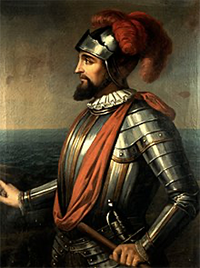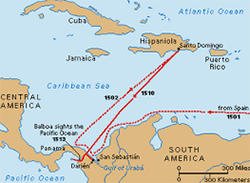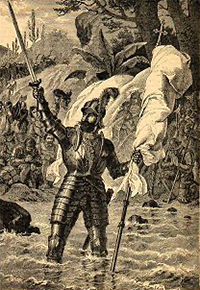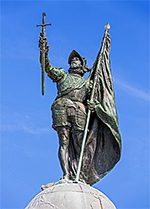Vasco Núñez de Balboa: Claimer of the Pacific
Vasco Núñez de Balboa was a Spanish explorer most well-known for being the first European to see the Pacific Ocean. 
He was born in 1475 in Jeréz de los Caballeros, in the Castilian province of Extremadura. His family were of noble lineage but didn't have much money; as well, Balboa was the third son and so couldn't hope for much in the way of inheritance as long as his two longer brothers were alive. In those days, the oldest brother was the heir apparent to titles and lands, the second-oldest son went into the clergy, and the third-oldest son was expected to join the military. This Balboa did. He trained as a knight and a soldier and did time as both page and squire for Don Predro de Portocarrero, lord of Moguer. In 1500, when he was 25, Balboa joined an expedition to South America led by Rodrigo de Bastidas. They sailed around the area for a time, and then some went back to Spain and some did not. Balboa ended up on the island of Hispaniola and set up his own farm. His skills and luck were poor, and he found himself having to borrow money and then run away in order to avoid being punished by debt collectors. He stole onto a ship headed for San Sebastián de Urabá, in what is now Colombia. He and his dog hid in a barrel to avoid detection but were found out. The ship's captain, MartÍn Fernández de Enciso, didn't appreciate the stowaway and was about to leave him behind when Balboa made an impassioned speech and convinced the captain to take him at least to their destination. The captain was impressed by Balboa's words and by his knowledge of the area that was their destination. (He had explored the Pearl Coast on his a previous expedition.) When they arrived, they discovered that the settlement was no more and that survivors of an attack by locals were few. The two groups combined and set out into the Darién, a jungle region between what are now Colombia and Panama. They survived an attack by a group of indigenous people and founded the city of Santa MarÍa la Antigua de Darén; this was the first permanent settlement on the mainland of either North America or South America. At that point, a power struggle ensued and Balboa came out on top, ousting in the process Enciso, the ship's captain who had shown him mercy. The surrounding area was known as the Veragua, and Balboa convinced the Spanish Crown to name him governor of the area. 

Stories came to Balboa and his men of a great body of water nearby and of a rich kingdom to the south of their position. He had, after all, set out on that first expedition in search of the riches that Christopher Columbus and other explorers had claimed were to be found in the New World. In 1513, Balboa decided to go have a look, along with about 200 men. They marched south, fighting their way through what is now the Isthmus of Panama, and, on September 25, saw what is now the Pacific Ocean. Balboa called it the South Sea. He waded into it and claimed all of it and its shores for Spain. It wasn't long until the Spanish Crown decided to replace Balboa. King Ferdinand II named the military commander PedrarÍas Dávila (more well-known as Pedrarias) to replace Balboa as Governor of Veragua. Pedrarias landed at the head of a large expedition and took over the governorship. Balboa did not fight the demotion, instead trying to convince men to join him on another expedition to the south. He continued to be more popular with the people than Pedrarias was, and the new governor proved to be not all that adept at running a colony. The two men clashed. As an attempt to keep the peace, Pedrarias offered his daughter as a wife for Balboa. The explorer agreed and married MarÍa de Peñalosa. The technicality was that she was in a convent in Spain at the time and, in fact, never left that convent. Balboa married her by proxy and eventually became estranged again from his father-in-law. 
Balboa finally decided to leave and convinced 300 men to go with him, to the town of Aclo. Pedrarias, still fearing that Balboa would try to unseat him, ordered a squadron of soldiers to arrest him and bring him back in chains. The leader of the expedition that did this was Francisco Pizarro, who would go on to conquer the Inca. Pizarro and his men found Balboa and brought him back so that he could answer to a charge of insurrection. He protested his innocence but was found guilty and killed, in January 1519. People many years later remember Balboa the way his subjects did, kindly. The national currency of Panama is the Balboa. Panama City has a monument to him and streets, parks, and a district that bear his name. Notably, his name adorns streets and parks in the United States as well. |
|
Social Studies for Kids
copyright 2002–2025
David White




